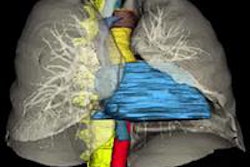Tuesday, December 2 | 11:40 a.m.-11:50 a.m. | SSG14-08 | Room S403B
In this talk, German researchers will describe how their semiautomated analysis software can quantitatively assess the quality of CT images.One of the major developments in radiology is the trend toward quantitative imaging, for which CT is particularly well-suited, said presenter Gregor Pahn, a physicist at University Hospital Heidelberg.
"The high spatial resolution and geometric accuracy as well as the quantitative image grayscale lead to a growing number of quantitative CT applications, e.g., for the precise determination of distances and volumes (tumor growth)," or organ segmentation based on Hounsfield units, Pahn told AuntMinnie.com. "If the results from these applications are to be accepted and relied upon by radiologists, rigorous demands on accuracy and stability of CT imaging systems have to be satisfied, and standardized procedures for quality assurance should be established."
The group developed novel analysis software that can be applied to image datasets acquired from standardized phantom measurements, Pahn said. Image quality can be evaluated quantitatively in terms of CT number accuracy, noise magnitude and power spectrum, uniformity across the field-of-view, contrast-to-noise ratio, and spatial resolution.
The software is time-efficient and offers high statistical reliability, Pahn said.
"The new tool enables comprehensive semiautomatic image quality assessment as a basis for quality assurance, but also allows for systematic comparison of image quality for different image reconstruction algorithms, acquisition protocols, and scanner models," he said. "The latter is of great relevance when third-party software is employed for quantitative studies or when CT hardware from different manufacturers and product series is used concurrently, such as in multicenter studies."




















